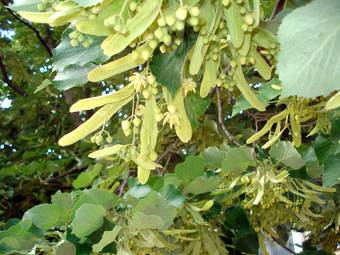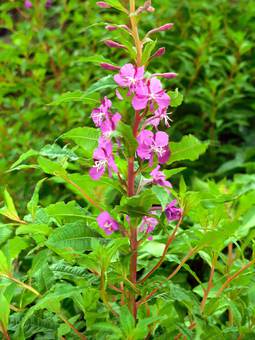Mount Vermio herbs
#PureNaoussa Mount Vermion is one of the richest in diverse vegetation due to its morphology, waters and climate conditions. Two and a half thousand years ago Herodotus wrote that the gardens of Midas with the famous roses were on Mount Vermion. The mountain boasts a feast of colours and perfumes with hundreds of wild flowers and pharmaceutical herbs. Some of them are of unique beauty such as the red lilium, peony, wild carnations, etc.
At the low altitudes of Mount Vermion one can find mostly bush, such as privets, peppertrees, arbutus as well as trees, such as plantains, linden, etc. while higher up the mountain, there are chestnut and beech trees, and even higher oak, pine and very tall fir trees.
The people from Naoussa have always known the beneficial qualities of the herbs in our mountain which they have used to cure several diseases, carefully, however, because of the toxicity of some. We are very careful at collecting them, we follow the experts’ advice and we are not greedy with their collection because we do not want to ruin the herbs’ root system which might lead to their extinction. We carefully consider that the collection of large volume of herbs is illegal particularly in certain protected areas as NATURA 2000.
We will start our tour with the most usual and common herbs of our mountain. We are grateful to Mr Nikolaos Kirou, an honorable teacher, for the texts, the photographs and his valuable help.
The information below is relevant to the pictures.
The mountain tea
(Sideritis)
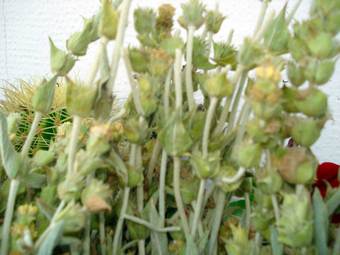
It can be found in abundance on our mountain in three different types, the yellow and the white which is the rarest and can, at times, be found as a green ‘variation’. We usually collect it in July. It has stimulating, expectorant, antithrombotic, antihypertensive, antioxidant, antianemic, spasmolytic, sweating and diuretic qualities. It helps digestion, it is good for colds, cough and generally respiratory problems, it stops diarrhea and dissolves kidney stones.
Chamomile
(Marticarie chamomilla)
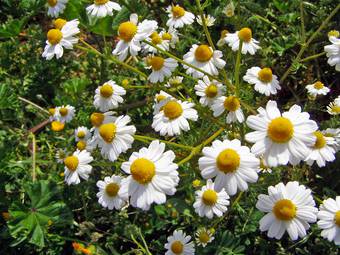
It is an annual, herbaceous plant which grows in the meadows,mostly among cereals, or on fences, or even on road edges. It blooms from May to September. It is used for its soothing, anti-inflammatory, diuretic, digestive, tranquilizing, antimicrobial, healing and many other qualities.
Mint
(Mentha aquatica)
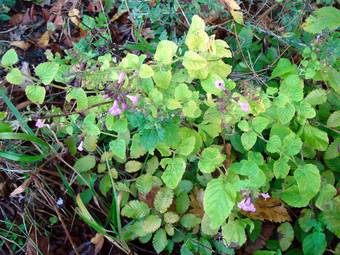
We can find it on the St Nikolaos grove and other parts of Mount Vermion in different types. It is an aromatic plant which blooms from July to October. The mint leaves are used as a taste amplifier in cooking. The mint essential oil is used in perfumery, soap making, confectionery and distillery. The mint drink has stimulating and antispasmodic qualities, it helps digestion, its sooths bile pains, it addresses nervous disorders, vertigo, fast heartbeat, etc.
Sabucos
(Sambucus nigra)
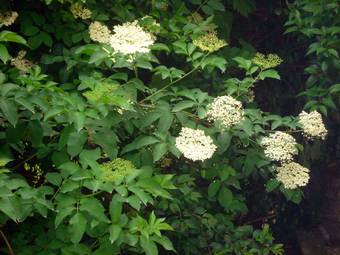
It is a beautiful big bush, almost the size of a tree with wonderful fragrant flowers which decorate not only the Vermion slopes and the St Nikolaos grove but also gardens and road sides. The flowers, the leaves, the bark and the fruit are all used in cooking, confectionery, hair dyeing, cosmetics, etc. It also has pharmaceutical qualities. Its leaves are used as a drink for colds, the flu, sinusitis, throat pain, tonsillitis, etc.
Salepi
(Orchis)
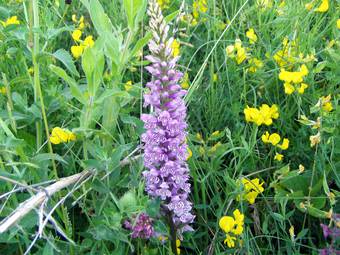
This is the name for a number of plants which belong to Orchidaceae family. It grows in the spring and at thebeginning of the summer. Its root is mostly used in the form of powder to produce one of the healthiest winter drinks. Salepi is a stimulating, softening, expectorant and warming drink. It helps with the cough, the flu, the cold and the healing of the stomach ulcer, diarrhea, dysentery, etc.
Thyme
(Thymus vulgaris)
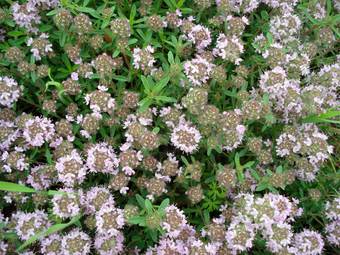
It is a small, herbaceous plant which grows in dry, stony ground. Its leaves and flowers produce essential oil with a well-known fragrance. It blooms in the spring and the summer, usually from May to July. The leaves and flowers are used in cooking, as well as a pharmaceutical herbal essential oil, syrup or fusion. Thyme has digestive, tranquilizing, antibacterial, antispasmodic, antifungal, diuretic, anthelmintic and other qualities.
Calendula
(Calendula officinalis)
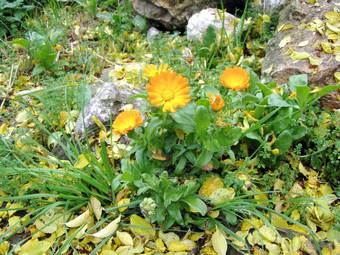
It is a biennial plant with thick, lanceolate leaves and beautiful orange-yellow flowers in the shape of a daisy. It blooms all year round in meadows and road sides and on the mountain foot. It is used for the production of cosmetics and as a pharmaceutical herb or its sweating, expectorant, antispasmodic and many other qualities.
Bellantona
(Atropa bellantona)
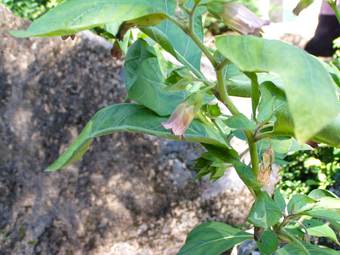
It is a rare, poisonous herb known from antiquity for its many pharmaceutical qualities. It can be found in relatively high altitude. It has lanceolate leaves with mauve flowers in the shape of a small bell. Its roots and leaves are used as a tranquilizer and antispasmodic, etc. with a medical prescription only.
Dititalis
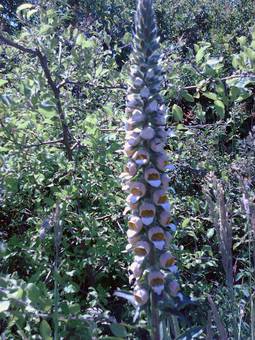
There are four kinds to be found on mount Vermion. They all bloom in the summer (June - September). Digitalis plants are poisonous and it is advisable not to try them without an expert’s advice. They have cardiotonic and diuretic qualities. They can also be applied externally to relieve pain and rheumatism.
Wild rose
(Rosa camina)
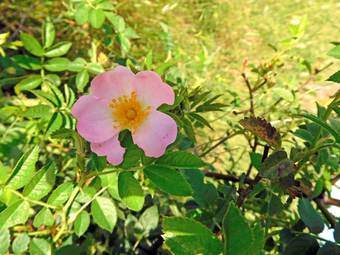
It is a thorny bush which mostly grows in the St Nikolaos grove and other areas on the foot of our mountain. It blooms in the spring (April –June). Its leaves, flowers and seeds are used for their pharmaceutical qualities which are revitalizing, stimulant, diuretic, styptic, etc.
They are used to treat diarrhea, kidney colics, wound healing, etc. The drink from wild rose seeds is rich in vitamin C.
Nigella
(Nigella damascene)
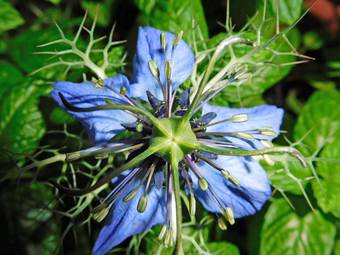
It is a small annual herbaceous plan which grows on the foot of our mountain as well as the sides of the roads and fields. Nigella is a pharmaceutical plant. Its seeds are mostly used for the treatment of the digestive system, kidney stones, arthritis, skin conditions as well as for its sweating, diuretic, anthelmintic, antiparasitic, fungicide and other qualities. The Nigella seeds are used in cooking to produce bread, tsoureki, etc.
Rockrose
(Cistus creticus)
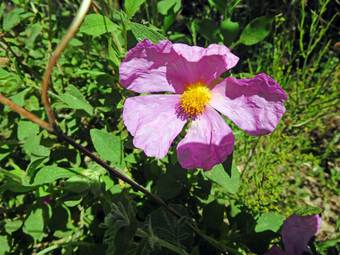
It is a bush of about 1,5 metres. The very well-known oil is produced from its leaves with many pharmaceutical qualities. It is used as a strong antioxidant. It has soothing qualities for insomnia. It is used for the treatment of toothaches, the digestive system (in diarrhea), bacterial infections, mycosis, etc. The drink from the leaves helps treat colds, the flu and other respiratory conditions. The ointment is used for the treatment of skin conditions and hair loss.
Arbutus, strawberry plant
(Arbutus officinalis)
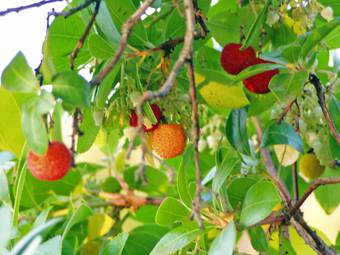
It grows both in Naoussa and Veria. Its fruit is used for the production of tsipouro, a strong alcoholic drink and liqueurs, marmalade or fruit sweets. The plant is known since ancient Greece for its pharmaceutical qualities. And has been used ever since for the treatment of several conditions. The leave infusions help treat kidney stones, bowel and bladder conditions, diarrhea, constipation, thrombophlebitis, etc. The arbutus honey helps to control cholesterol.
Campanula, Bluebell
(Campanula spatulata)
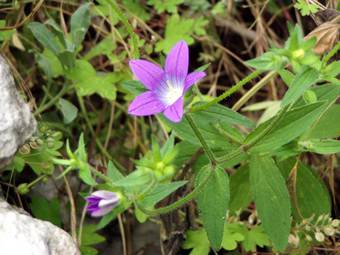
It grows on our mountain in many different types. They are herbaceous plants blooming during the spring and summer. They contain many valuable chemical substances such as resin, tannins and gallic acid which give them important pharmaceutical qualities (anti-inflammatory, styptic, etc.). The roots, flower and leaves, either dried or tender, are used in different concoctions to treat respiratory conditions (catarrh, pharyngitis, laryngitis, etc.) conditions of the oral cavity (stomatitis, inflammation of the gums), conditions of the eye (blepharitis, conjunctivitis, etc.). The bluebell infusion is also used for the treatment of skin conditions.
Wild carnation
(Dianthus Cruentus)
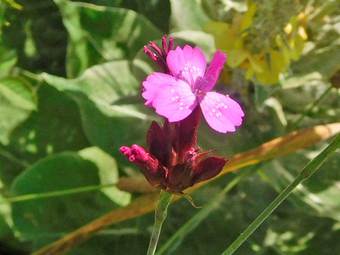
It is a perennial bush which grows in dry climate and can reach up to 60 cm in height. Since ancient times the wild carnation is used for its pharmaceutical qualities because of its precious chemical substances. Its dried leaves are used mostly to treat conditions of the urinary system (urinary tract infections, etc.), skin conditions, problems of the digestive system, etc. always under strict medical supervision.
Taraxacum
(Taraxacum officinalis)
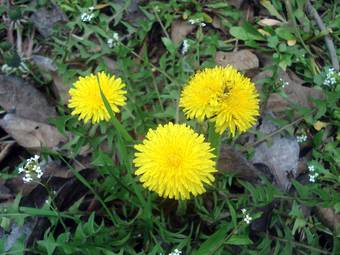
It is a wild chicory, a common herbaceous plant which grows on the mountain and in the fields of Naoussa and it is mostly used in salads. It has
many vitamins (A, B, C, D), minerals (ferrum and potassium) and other substances. The leave juice and the root are used for their blood cleaning qualities, for liver and spleen problems, indigestion, constipation, cholesterol, skin problems (eczema, moles, etc.) and rheumatism. Its leaves and roots also have appetizing, revitalizing, digestive and diuretic qualities.
Wild strawberry
(Fragaria verca)
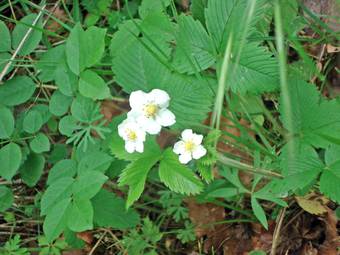
It is a perennial herbaceous plant which grows in several altitudes, in meadows, road and trail sides. It blooms at the end of the spring and its
fruit matures in the summer. Its seeds have many vitamins and minerals with antioxidant qualities. Its fruit, roots and leaves are used for their revitalizing, diuretic, appetizing, laxative and many other qualities.
Chicory
(Cichorium intybus)
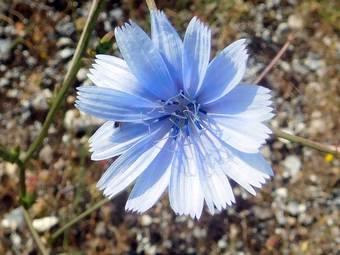
It is a perennial plant with a hard sprout. Chicory is known since antiquity with revitalizing, diuretic, digestive, laxative, stimulating, tranquilizing,
anti-inflammatory, antibacterial and many other qualities. It contains ferrum and many vitamins. It is used for the treatment of cholelithiasis, constipation, cholesterol, high blood sugar, fast heartbeat, anorexia, liver, kidney and urinary conditions. Its juice can be used for the treatment of skin conditions.
Celandine
(Chelidonium majus)
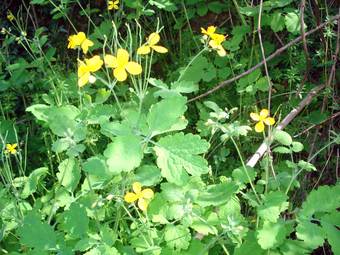
It is about 30 – 90 cm biennial plant with a thick root and an upstanding sprout with many twigs. It blooms in the spring. It is used for the treatment of gallstones, gout, hydropic, hemorrhoids, arteriosclerosis, skin conditions, etc. It must be used with extra caution, always under medical supervision and in very small doses.
Valeriana
(Valeriana officinalis)
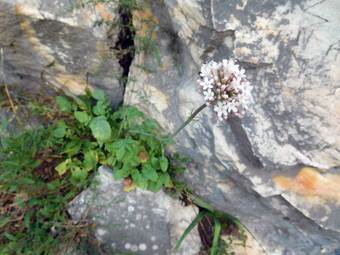
Valeriana is one of the most well-known herbs with many pharmaceutical qualities. It can be found in humid places, near streams, on the foot of our mountain, as well as in story ground and non-cultivated fields. It blooms from April till July and it is used for sedative, muscle relaxant, pesticide, expectorant, cardiotonic and other qualities, for the treatment of epilepsy, insomnia, headaches, migraines, indigestion and dandruff. The roots, leaves or flowers are mostly used in different concoctions.
Violet
(Viola odorata)
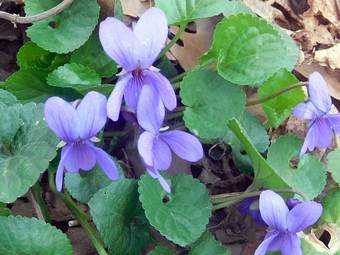
The wild violets decorate the Vermion woods with their beautiful colours and scents in the spring. At the St Nikolaos grove one can find two types, riviniana and odorata with mauve flowers, while Viola tricolor grows in the 3-5 Pigadia area with orange-yellow flowers. The plant has many pharmaceutical herbs. The Viola tricolor roots and leaves are used for their analgesic, vomiting and laxative qualities, its roots also have vomiting and laxative qualities. Its flowers are used as sedatives, to sooth coughs, headaches, migraines and coughs.
Cyclamen
(Cyclamen graecum)
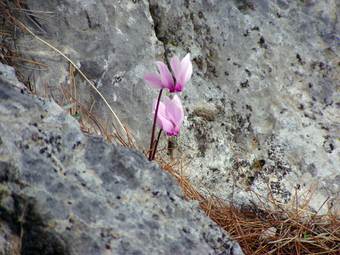
It grows in fairly low altitude inside the woods. In the fall, it the flowers which bloom first and then the leaves stem out. Its flowers are mauve
– pink with five petals turning backwards with a mild scent. Cyclamen has been known as a decorative plant and it is grown in gardens and
parks. It also has therapeutic qualities. Its poisonous root has laxative, emmenagogue and anthelmintic qualities and it can be used for the
treatment of catarrh and ear conditions under strict caution. Its flowers are used for skin treatments and they help to eliminate freckles.
Rusk
(Ruscus aculeatus)
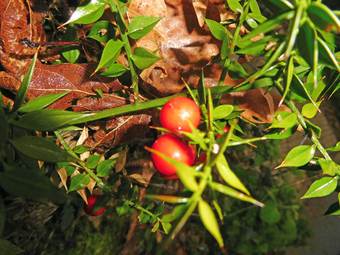
It is met in the St Nikolaos grove and a little higher up the mountain. One can identify the plant by its hard, little leaves which end in thorns, among which the red, cherry-like fruit grows. Since antiquity, rusk is used as a pharmaceutical herb and as an appetizer. From its roots and stems, which contain resin, essential oils, calcium and other minerals, drinks with laxative and diuretic qualities are produced to treat kidney diseases, fever, etc. Nowadays, several concoctions are used to relieve people from edema, varicose veins, phlebitis, hemorrhoids, gout, jaundice, etc.
Primrose
(Primula vulgaris)
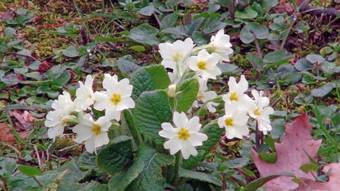
It grows in many colours in the St Nikolaos grove and many other areas on the foot of mount Vermion. It takes shady space and wet ground
to flourish. It is a pharmaceutical herb used for rheumatism, arthritis, muscle pains, insomnia, skin conditions, etc. It has soothing, antispasmodic, expectorant and beautifying qualities. Its flowers are used in the form of ointment to treat skin conditions, e.g skin blemishes, sunburns, measles, etc. Its root and flowers have expectorant qualities and as a drink it helps whooping cough, bronchitis, cough, cold and other respiratory conditions.
Anemone
(Anemone pavonina)
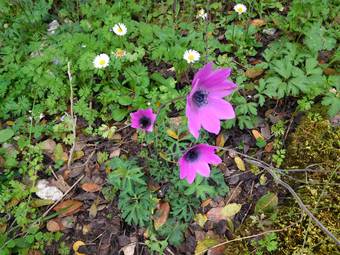
It is met in meadows in many areas of our mountain. It grows from a bulb with lanceolate leaves and mauve flowers 4-5 cm in diameter and 7-9 sepals. It reaches 15 – 20 cm in height. It is used as a pharmaceutical herb to treat insomnia, headaches and migraines, problems of the
genitals, otitis, etc. It is also used as analgesic, antibacterial, antispasmodic and neurotonic.
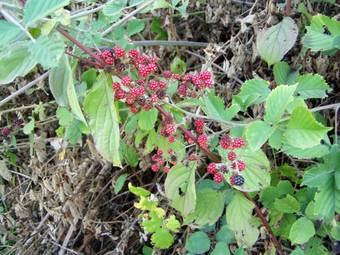
It is the well-known bush we can find in the St Nikolaos grove and on the foot of mount Vermion as well as a rather annoying bush on the field fences. Its fruit, the blackberry is red and when it ripens, it turns black. It contains many vitamins, A, B, C and E, citric and apple acid, sugar, pectin, tannins and minerals (ferrum, calcium, etc.) used for their stimulant, antioxidant, diuretic, expectorant, styptic and other qualities. It is
also used to treat anemia, gynecological, respiratory, urinary and digestive systems as well as skin conditions, etc.
Veronica
(Veronica officinalis)
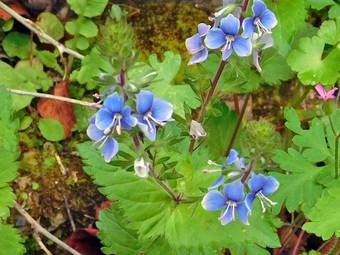
It grows in the St Nikolaos grove and other areas of our mountain. It blooms at the end of the spring and the beginning of the summer. Pharmaceutical Veronica has special qualities. Its leaves and flowers are used for the production of a drink with stimulant, digestive, sweating and expectorant qualities to treat skin, urinary, eye and other conditions, always on medical advice.
Colchicum
(Colchicum automnuale)
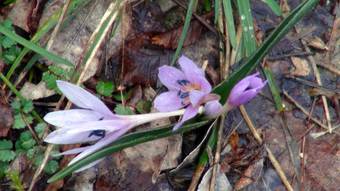
A beautiful small flower which blooms on the mountain slopes and in the wood clearings. It has light coloured mauve flowers and pointed, lanceolate leaves which spring from its bulb at the fall. It’s been known and used since the Byzantine times as a pharmaceutical herb. Its bulbs and seeds are used for arthritis, gout, rheumatism and for its diuretic, analgesic, laxative and other qualities under medical supervision because it is a strong poison. As it looks very much with crocus, we must not mix up the two.
Juniper
(Juniperus communis)
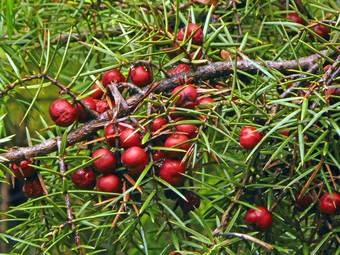
It is a perennial bush which can be found in the St Nikolaos grove, St Theologos hill and even higher. It blooms in the spring with two types of
flowers, the male which looks like small, yellow cones and the female which are green with three spots. Its green – blue fruit is small and
round, however for some varieties it is red or brown. It contains resin with a distinctive smell which is used for the production of drinks and in
cooking for its aroma and the production of sauce, etc. Its fruit’s pharmaceutical qualities help the treatment of gout, scabies and other skin conditions. It also has stimulating, digestive, disinfectant and other qualities.
Mallow
(Malva silvestris)
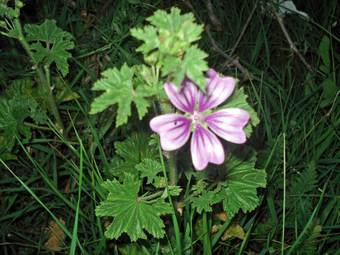
A very common biennial wild flower which grows on the mountain meadows, in fields, parks, etc. It has palm-shaped leaves and mauve flowers with 5 separate petals and a large white pistil in the centre of the flower. It blooms from the end of the spring until the fall. Its roots, flower and
leaves are used for qualities such as anticough, emollient, antiphlogistic, and to help with constipation, skin problems, etc.
Skorpidi - in Greek
(Ceterach officinarum)
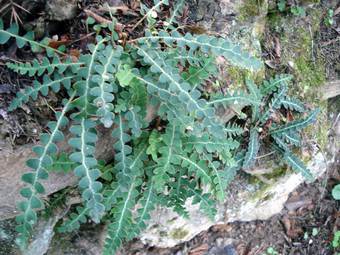
It can be found stuck on the rocks of the St Nikolaos grove and other areas of the mountain. It looks like a small fern. Its leaves are used for the production of a drink which heals several diseases of the urinary system such as kidney stones, etc. It is also used for its diuretic, anti-bronchitis, expectorant qualities and to help with spleen problems.
Periwinkle
(Vinca minor)
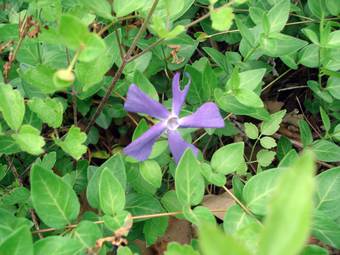
It grows at the mountainous road sides and meadows. It blooms in the spring and summer. It is also cultivated as a decorative flower. Its leaves and roots are used as a pharmaceutical herb with qualities such as digestive, revitalizing, hypotensive, diuretic and to help blood flow.
Lilies
(Lilium chalcedonicum)
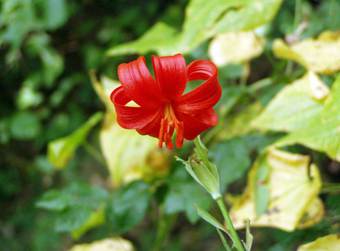
It is a very beautiful wild flower which grows in relatively high altitude on our mountain. It has red flowers, 5 cm in diameter which come out of
the sprout top (one - six flowers). They look downwards with six petals looking backwards. It has intense perfume. The plant blooms in June
and July. We do not know if the plant has any pharmaceutical qualities, it is well-known however since the antiquity.
Horsetail
(Equisetum arvense)
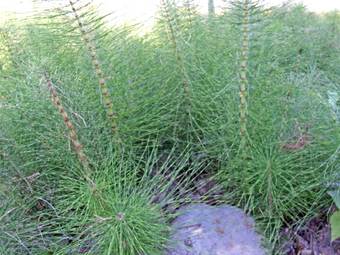
It is a perennial herbaceous plant which has a reedy sprout with leaves like threads. It looks like a horsetail and it can be found on the foot as well as other humid areas of the mountain (St Nikolaos grove, Aristrotle’s school, etc.). It has diuretic and hemostatic qualities; it is used for problems of the urinary system and for skin problems with external use.
Clematis
(Clematis vetalba)
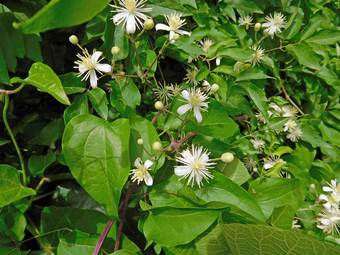
A perennial bush with long sprouts of up to ten metres. It has heart-shaped shiny leaves and small, white aromatic flowers with four sepals, and many large stamens which shape small bouquets. It blooms in the summer. It is a poisonous plant so people must be very careful when using it. In medicine, above-ground parts of the plant are used for its diuretic, laxative, pain-relieving and other qualities.
Yarrow
(Axillea millefolium)
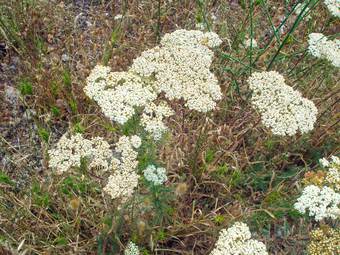
A beautiful perennial herbaceous plant which grows on the meadows of our mountain at several altitudes. It has lined leaves and its usually white flowers grow in small bouquets at the top of the sprout. The flowers have diuretic, antispasmodic, digestive, healing and other qualities.
Pentanevro
(Plantago major)
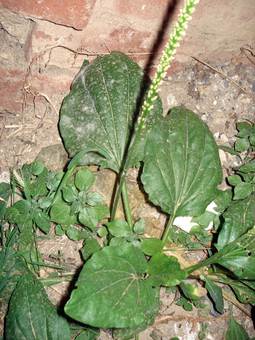
It is a perennial herbaceous plant which grows not only on the mountain but on the fields and the sides of the roads, etc. It has long,
lanceolate leaves with five nerves on. Its flower looks like a think grain ear. It blooms in the spring and summer. It is used to heal wounds, as diuretic, laxative, etc.
Peony
(Paeonia mascula)
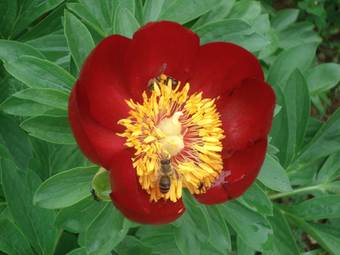
It blooms from the end of April until early June with large, impressive flowers of about 8 cm in diameter which usually have 7 petals and a discreet cinnamon scent. It can be found at Giannakohori village and other areas of the mountain. Peony has been known since antiquity for
its beauty and its many pharmaceutical qualities. Today it is used as a painkiller and a mild drug. The beautiful plan must be dealt with particular care as, apart from essential oil it also contains dangerous poisons.
Ivy
(Hedera helix)
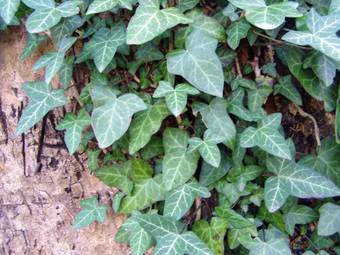
It is a perennial climbing bush. It encircles the plantain trunks in the St Nikolaos grove and other trees in several areas of our mountain. It has large, shiny, heart-shaped leaves and small, yellowish flowers. Its fruit is poisonous and can be used in medicine for its emmenagogue, laxative, expectorant and other qualities.
St John’s wort
(Hypericum perforatum)
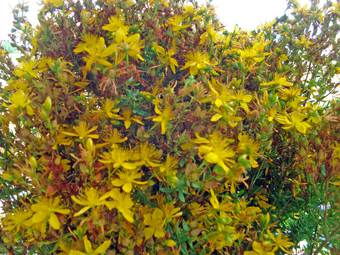
It is a perennial herbaceous plant 50-80 cm high. Its small lanceolate yellow leaves have 5 petals and many stamens which look like a bouquet. It blooms at the end of spring. Its flowers, either fresh or dried, are used as antiseptic, styptic and anti-inflammatory.
